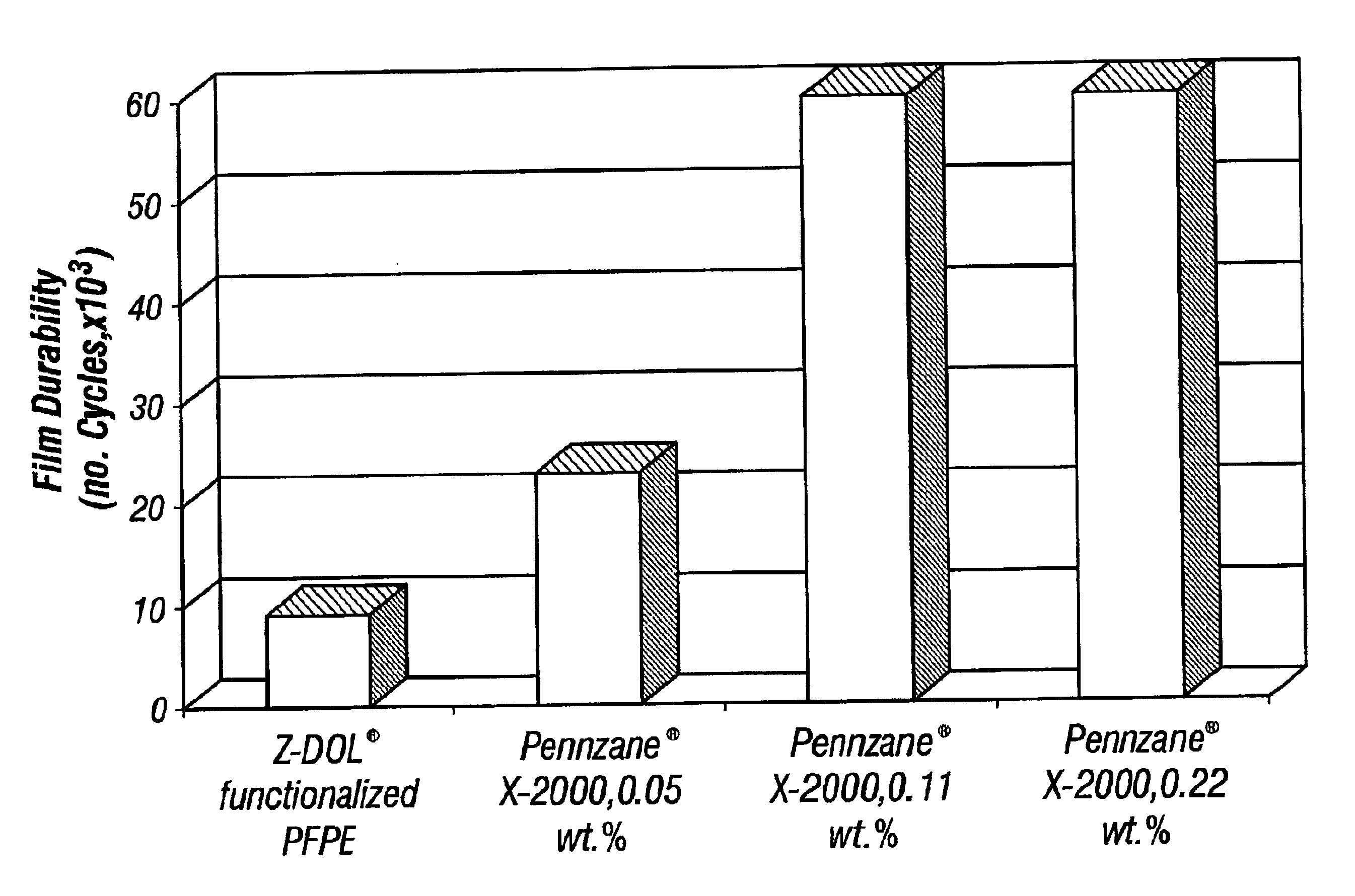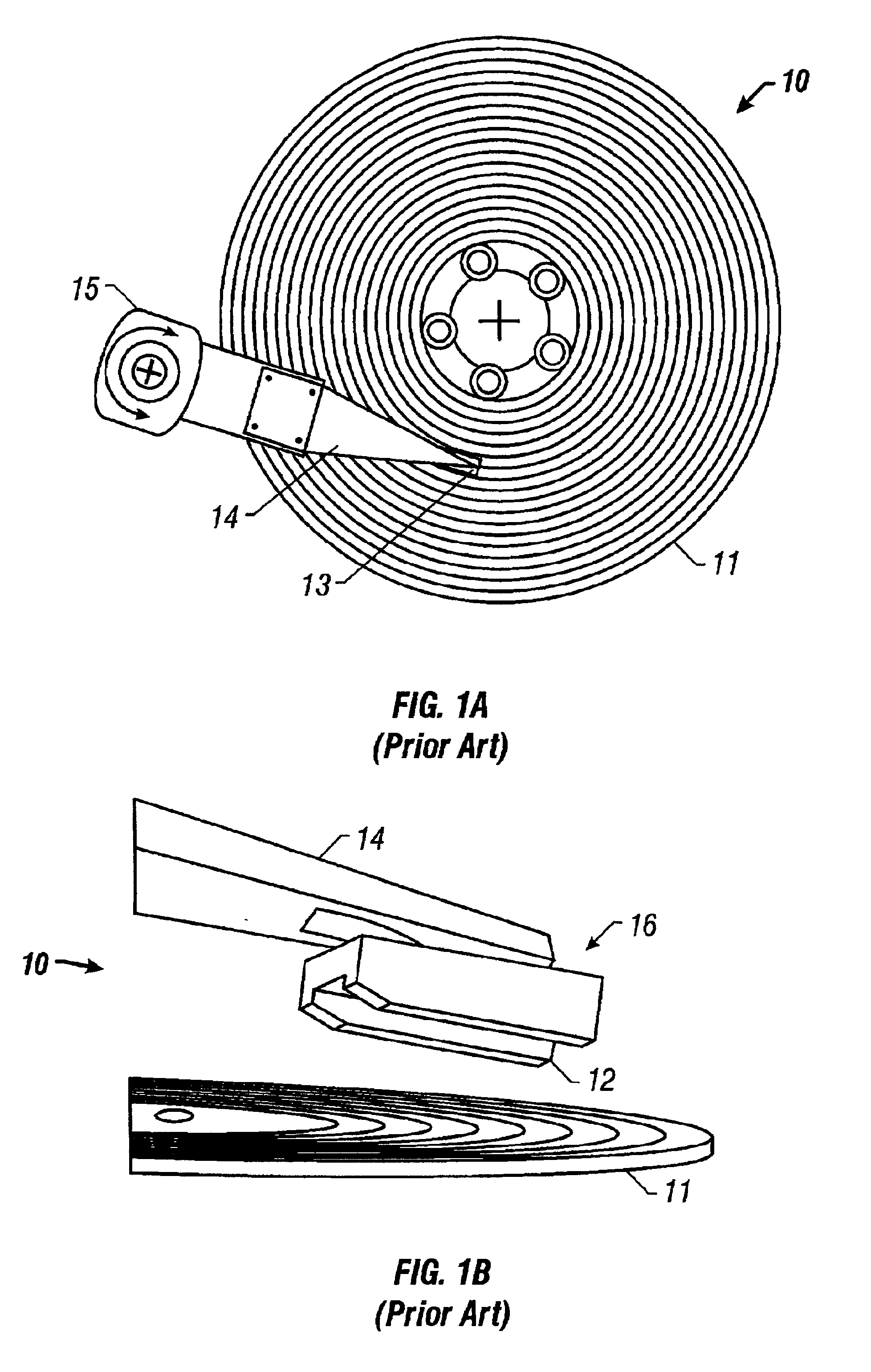Lubricant for magnetic recording medium and use thereof
a technology of magnetic recording medium and lubricant, which is applied in the field of magnetic recording medium, can solve the problems of contact, non-uniform load on the head, damage to the head and the surface of the magnetic disk,
- Summary
- Abstract
- Description
- Claims
- Application Information
AI Technical Summary
Benefits of technology
Problems solved by technology
Method used
Image
Examples
example 1
[0148]This example demonstrates that Pennzane® X-2000, a lubricant made of tris-(2-octyldodecyl)cyclopentane, has a lower friction coefficient and comparable wear resistance to Z-DOL®, an existing lubricant. Pennzane°X-2000 is a product available from Pennzoil-Quaker State, Inc., Houston, Tex. Z-DOL® is a functionalized PFPE manufactured by Ausimont Montedison.
[0149]For comparison, Pennzane® X-2000 and Z-DOL® samples were tested for wear scar. Their friction coefficients also were measured. The tests were conducted in accordance with ASTM D5707-95 and DIN 51 834 methods. A description of the ASTM D5707-95 and DIN 51 834 methods can be found in the article entitled: New ASTM and DIN Methods for Measuring Tribological Properties Using the SRV® Test Instrument, printed in NLGI Spokesman, Vol.60, No. 12, page 17 (March 1997). This article is incorporated by reference in its entirety herein.
[0150]The test results are summarized in Table I. A number of additives were used with Pennzane® X...
example 2
[0153]This example demonstrates that Pennzane® X-2000 lubricant films formed on a magnetic medium have a longer lifetime in contact-start / stop cycles than Z-DOL® lubricant films.
[0154]A number of samples that included a magnetic medium with a lubricant film formed thereon were prepared. Lubricant films of both Pennzane® X-2000 and Z-DOL® were deposited on amorphous hydrogenated carbon overcoated disks. The lubricant films were formed by dipping the magnetic medium disks into a solution containing the respective compositions at a specified weight percentage. 1,1,2-trichloro-trifluoroethane was used as the solvent for Z-DOL®, whereas cyclohexane was used as the solvent for Pennzane® X-2000. These samples were tested in an apparatus called a High-Velocity Ball-on-Inclined-Plane (“HVBOIP”) tester, which generates tribological conditions similar to the magnetic head / disk interface in a computer disk drive.
[0155]FIG. 3 shows schematically the top view of the HVBOIP tester 30. Referring to...
example 3
[0162]This example demonstrates that Pennzane® X-2000 lubricant films which contain one or more additives formed on a magnetic medium have a longer lifetime in contact-start / stop cycles than Z-DOL® lubricant films.
[0163]Four samples (Sample Nos. 5-8) that included a magnetic medium with a lubricant film formed thereon were prepared. One sample (Sample No. 5) included a magnetic medium with a Z-DOL® lubricant film formed thereon. Three samples (Samples Nos. 6-8) included a magnetic medium with a Pennzane® X-2000 lubricant film formed thereon which contained one or more additives. The lubricant films were deposited on amorphous hydrogenated carbon overcoated disks using the dip procedure described in Example 2. The four lubricant films were formed by dipping the magnetic medium disks into a solution containing the respective compositions at a specified weight percentage. 1,1,2-trichloro-trifluoroethane was used as solvent for Z-DOL®, whereas cyclohexane was used as solvent for Pennzan...
PUM
| Property | Measurement | Unit |
|---|---|---|
| Fraction | aaaaa | aaaaa |
| Fraction | aaaaa | aaaaa |
| Fraction | aaaaa | aaaaa |
Abstract
Description
Claims
Application Information
 Login to View More
Login to View More - R&D
- Intellectual Property
- Life Sciences
- Materials
- Tech Scout
- Unparalleled Data Quality
- Higher Quality Content
- 60% Fewer Hallucinations
Browse by: Latest US Patents, China's latest patents, Technical Efficacy Thesaurus, Application Domain, Technology Topic, Popular Technical Reports.
© 2025 PatSnap. All rights reserved.Legal|Privacy policy|Modern Slavery Act Transparency Statement|Sitemap|About US| Contact US: help@patsnap.com



